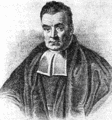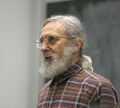Template:Selected anniversaries/April 7: Difference between revisions
No edit summary |
No edit summary |
||
| Line 35: | Line 35: | ||
||1882: Hermann Pokorny born. He was a World War I Austro-Hungarian Army cryptologist whose work with Russian ciphers contributed substantially to Central Powers victories over Russia. Pic. | ||1882: Hermann Pokorny born. He was a World War I Austro-Hungarian Army cryptologist whose work with Russian ciphers contributed substantially to Central Powers victories over Russia. Pic. | ||
||1887: Carl Krauch born ... chemist, industrialist and Nazi war criminal. He was an executive at BASF (later IG Farben); during World War II, he was chairman of the supervisory board. He was a key implementer of the Reich’s Four-Year Plan to achieve national economic self-sufficiency and promote industrial production. He was Plenipotentiary of Special Issues in Chemical Production. Pic. | |||
File:Paul Du Bois-Reymond Heidelberg.jpg|link=Paul du Bois-Reymond (nonfiction)|1889: Mathematician [[Paul du Bois-Reymond (nonfiction)|Paul David Gustav du Bois-Reymond]] dies. He worked on the theory of functions and in mathematical physics. | File:Paul Du Bois-Reymond Heidelberg.jpg|link=Paul du Bois-Reymond (nonfiction)|1889: Mathematician [[Paul du Bois-Reymond (nonfiction)|Paul David Gustav du Bois-Reymond]] dies. He worked on the theory of functions and in mathematical physics. | ||
Revision as of 02:40, 3 May 2020
1761: Mathematician, philosopher, and minister Thomas Bayes dies. He is remembered for having formulated a specific case of the theorem that bears his name: Bayes' theorem.
1788: Mathematician and APTO field engineer Louis François Antoine Arbogast defeats the Forbidden Ratio in single combat by separating the symbols of operation from those of quantity.
1811: Astronomer, mathematician, and philosopher Hasan Tahsini born. He will become one of the most prominent scholars of the Ottoman Empire of the 19th century.
1860: Physicist and crime-fighter Ernst Ruhmer invents a camera which uses the light-sensitivity properties of selenium to record images from past and future events. This type of camera is popular with math photographers, notably Cantor Parabola.
1866: Mathematician Erik Ivar Fredholm born. He will introduce and analyze a class of integral equations now called Fredholm equations. Fredholm's work on integral equations and operator theory will anticipate the theory of Hilbert spaces.
1867: Gem detective Niles Cartouchian works with Hasan Tahsini to recover stolen shipment of time crystals (nonfiction).
1889: Mathematician Paul David Gustav du Bois-Reymond dies. He worked on the theory of functions and in mathematical physics.
1899: Physicist and academic Petrus Leonardus Rijke dies. He explored the physics of electricity, and is known for the Rijke tube (which turns heat into sound, by creating a self-amplifying standing wave).
1903: United States Navy Admiral Edwin Thomas Layton born. Layton will serve as a Naval intelligence officer before and during World War II.
2014: Mathematician and academic Tim Cochran born. He will contribute to topology, especially low-dimensional topology, the theory of knots and links and associated algebra.
1995: Mathematician and crime-fighter Donald Erik Sarason combines Hardy space theory with Vanishing mean oscillation (VMO); in the process, he will discover radical new techniques for detecting and preventing crimes against mathematical constants.
1995: Math photographer Cantor Parabola takes a series of photographs which capture temporal superimpositions from physicist and academic Petrus Leonardus Rijke in the form of a self-amplifying standing wave.
2009: Game designer Dave Arneson dies. He co-created the pioneering role-playing game Dungeons & Dragons with Gary Gygax.











